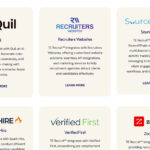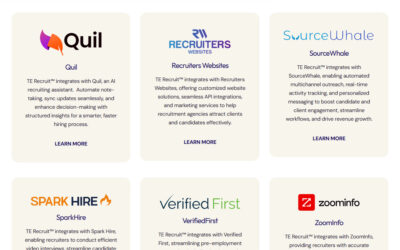In today’s competitive job market, agency recruiters and search consultants must leverage every tool at their disposal to attract top talent. One of the most powerful tools available is the careers page within your applicant tracking system (ATS) or recruiting software. An effective careers page can serve as a magnet for high-quality candidates, streamline the recruitment process, and ultimately lead to more successful placements.
This blog post will explore the best practices for using your careers page to find top talent and make more placements.
Understanding the Importance of a Careers Page
Attracting Top Talent
A well-designed careers page is often the first point of contact between your agency and potential candidates. It serves as a digital storefront, showcasing your brand, values, and job opportunities. An engaging and informative careers page can attract top talent by providing a clear picture of what it’s like to work for your clients or your agency.
Streamlining the Application Process
An effective careers page integrates seamlessly with your ATS or recruiting software, making it easy for candidates to apply for positions. By streamlining the application process, you can reduce candidate drop-off rates and ensure that you capture the interest of top talent.
Enhancing Employer Branding
Your careers page is an extension of your employer brand. It communicates your agency’s values, culture, and commitment to candidates. A strong employer brand can differentiate you from competitors and make your agency more attractive to top talent.
Best Practices for Designing and Managing Your Careers Page
1. Create a User-Friendly Design
A user-friendly design is essential for ensuring that candidates have a positive experience on your careers page. The design should be clean, intuitive, and easy to navigate.
Key Elements of a User-Friendly Design:
- Clear Navigation: Use a simple and intuitive navigation structure that allows candidates to find information easily. Include clear headings and subheadings for job categories, application instructions, and company information.
- Responsive Design: Ensure that your careers page is mobile-friendly and accessible on all devices. Many candidates will access your page from their smartphones or tablets, so it’s crucial that the design adapts to different screen sizes.
- Fast Loading Times: Optimize your careers page for fast loading times. Slow-loading pages can frustrate candidates and lead to higher bounce rates.
2. Highlight Employer Branding
Your careers page should reflect your employer brand and provide a compelling reason for candidates to apply. Highlight your agency’s or client’s values, culture, and unique selling points.
Key Elements of Employer Branding:
- About Us Section: Include an “About Us” section that provides an overview of your agency or client, including its mission, values, and culture. Use engaging language and visuals to create a positive impression.
- Employee Testimonials: Feature testimonials from current employees to give candidates an inside look at what it’s like to work for your agency or client. Testimonials can build credibility and trust.
- Company Culture: Showcase your company culture through images, videos, and descriptions of events, initiatives, and workplace practices. Highlight aspects that make your agency or client a great place to work.
3. Provide Detailed Job Descriptions
Clear and detailed job descriptions are crucial for attracting the right candidates. Ensure that each job listing includes all the necessary information and accurately represents the role.
Key Elements of Detailed Job Descriptions:
- Job Title: Use clear and descriptive job titles that accurately reflect the role.
- Responsibilities: Provide a detailed list of job responsibilities and tasks. Be specific about what the role entails.
- Requirements: Clearly outline the qualifications, skills, and experience required for the position. Include both essential and preferred criteria.
- Benefits: Highlight the benefits and perks associated with the role, such as salary range, healthcare, retirement plans, and professional development opportunities.
- Application Instructions: Provide clear instructions on how to apply, including any required documents and the application deadline.
4. Incorporate SEO Best Practices
Search engine optimization (SEO) is essential for ensuring that your careers page ranks well in search engine results and attracts organic traffic. Implementing SEO best practices can increase the visibility of your job listings and attract more candidates.
Key SEO Best Practices for Careers Pages:
- Keyword Research: Conduct keyword research to identify relevant keywords and phrases that candidates might use to search for jobs. Incorporate these keywords naturally into your job titles, descriptions, and headings.
- Meta Tags: Use descriptive meta titles and meta descriptions for each job listing. Meta tags help search engines understand the content of your page and improve click-through rates.
- Alt Text for Images: Add descriptive alt text to images on your careers page. Alt text helps search engines index your images and improves accessibility for visually impaired users.
- Internal Linking: Use internal links to guide candidates to other relevant job listings and pages on your website. Internal linking can improve navigation and SEO.
5. Integrate with Social Media
Social media integration can significantly expand the reach of your careers page and attract a wider audience. Promote your job listings on social media platforms to engage with potential candidates.
Key Strategies for Social Media Integration:
- Share Job Listings: Regularly share job listings on your social media profiles, including LinkedIn, Facebook, Twitter, and Instagram. Use eye-catching visuals and engaging captions to capture candidates’ attention.
- Engage with Followers: Respond to comments and messages from candidates on social media. Engaging with followers can build relationships and encourage applications.
- Employee Advocacy: Encourage employees to share job listings and company updates on their personal social media profiles. Employee advocacy can expand your reach and enhance your employer brand.
6. Simplify the Application Process
A complicated application process can deter top talent from applying. Simplify the process to ensure that candidates can easily submit their applications.
Key Elements of a Simplified Application Process:
- Minimal Required Fields: Limit the number of required fields in the application form to essential information. Avoid asking for unnecessary details that can lengthen the process.
- Resume Parsing: Use resume parsing technology to automatically extract relevant information from candidates’ resumes and populate application fields.
- Progress Indicators: Include progress indicators to show candidates how far along they are in the application process. Progress indicators can reduce frustration and keep candidates engaged.
- Save and Continue: Allow candidates to save their progress and return to complete their application later. This flexibility can accommodate candidates with busy schedules.
7. Use Analytics to Monitor Performance
Analytics tools can provide valuable insights into the performance of your careers page and help you identify areas for improvement. Use analytics to track key metrics and optimize your page for better results.
Key Metrics to Track:
- Page Views: Monitor the number of page views to assess the overall traffic to your careers page.
- Bounce Rate: Track the bounce rate to identify how many visitors leave your page without taking action. A high bounce rate may indicate issues with the content or design.
- Application Completion Rate: Measure the percentage of candidates who complete the application process. A low completion rate may suggest that the process is too complicated or time-consuming.
- Source of Traffic: Identify the sources of traffic to your careers page, such as search engines, social media, and referrals. Use this information to focus your marketing efforts on the most effective channels.
8. Foster a Positive Candidate Experience
A positive candidate experience is crucial for attracting top talent and building a strong employer brand. Ensure that candidates have a positive experience throughout the recruitment process, from their first visit to your careers page to the final interview.
Key Elements of a Positive Candidate Experience:
- Timely Communication: Communicate with candidates promptly and keep them informed about the status of their application. Timely communication shows respect and professionalism.
- Feedback and Follow-Up: Provide feedback to candidates after interviews and follow up with those who are not selected. Constructive feedback can help candidates improve and shows that you value their effort.
- Personalized Interactions: Personalize your interactions with candidates to make them feel valued and respected. Use their names and reference specific details from their application or interview.
9. Leverage Employee Testimonials and Success Stories
Employee testimonials and success stories can provide candidates with valuable insights into what it’s like to work for your agency or client. Highlighting real experiences can build credibility and attract top talent.
Key Strategies for Employee Testimonials and Success Stories:
- Authentic Stories: Share authentic stories from current and former employees about their experiences. Highlight different aspects of the work environment, career growth, and company culture.
- Diverse Perspectives: Include testimonials from employees in various roles and departments to provide a well-rounded view of the organization.
- Multimedia Content: Use a mix of written testimonials, videos, and images to engage candidates and showcase your employer brand.
10. Continuously Update and Improve Your Careers Page
A static careers page can quickly become outdated and less effective. Continuously update and improve your page to ensure that it remains relevant and engaging.
Key Strategies for Continuous Improvement:
- Regular Content Updates: Update job listings, company information, and employee testimonials regularly to reflect the latest opportunities and developments.
- A/B Testing: Conduct A/B testing to compare different versions of your careers page and identify the most effective design and content elements.
- Solicit Feedback: Gather feedback from candidates and employees about their experience with your careers page. Use this feedback to make improvements and enhance the user experience.
Case Studies: Success Stories of Effective Careers Pages
Case Study 1: A Tech Startup’s Engaging Careers Page
A tech startup faced challenges in attracting top talent due to its limited brand recognition. By revamping its careers page, the startup was able to significantly improve its recruitment outcomes.
Strategies Implemented:
- User-Friendly Design: The startup implemented a clean and intuitive design with clear navigation and fast loading times.
- Employer Branding: The page highlighted the startup’s innovative culture, mission, and values through engaging content and visuals.
- SEO Optimization: The startup optimized its careers page for search engines, resulting in higher visibility and organic traffic.
- Employee Testimonials: The page featured authentic testimonials from employees about their experiences and career growth.
Results:
- Increased Traffic: The careers page saw a 50% increase in traffic, with more candidates visiting and exploring job opportunities.
- Higher Engagement: Candidates spent more time on the page and engaged with the content, resulting in higher application rates.
- Successful Placements: The startup successfully attracted and hired top talent, leading to a 30% increase in successful placements.
Case Study 2: A Healthcare Recruitment Agency’s Simplified Application Process
A healthcare recruitment agency struggled with high candidate drop-off rates during the application process. By simplifying the process and enhancing the careers page, the agency achieved significant improvements.
Strategies Implemented:
- Simplified Application Process: The agency reduced the number of required fields and streamlined the application form for a faster and easier process.
- Mobile Optimization: The careers page was optimized for mobile devices to accommodate candidates applying from smartphones and tablets.
- Regular Updates: The agency regularly updated job listings and company information to ensure accuracy and relevance.
- Analytics and Monitoring: The agency used analytics tools to monitor page performance and identify areas for improvement.
Results:
- Reduced Drop-Off Rates: Candidate drop-off rates decreased by 40%, with more candidates completing the application process.
- Higher Application Rates: The simplified process led to a 35% increase in application rates, with more candidates submitting their resumes.
- Enhanced Candidate Experience: Candidates reported a positive experience with the application process, leading to higher satisfaction and engagement.
A well-designed and effectively managed careers page is a powerful tool for agency recruiters and search consultants. By implementing the best practices outlined in this guide, you can attract top talent, streamline the application process, and make more successful placements.
From creating a user-friendly design and highlighting employer branding to leveraging SEO and simplifying the application process, these strategies will help you maximize the potential of your careers page.
Continuously updating and improving your page, fostering a positive candidate experience, and leveraging employee testimonials and success stories will further enhance your recruitment efforts and build a strong employer brand. By harnessing the power of your careers page within your applicant tracking system or recruiting software, you can achieve greater success in finding and placing top talent.









